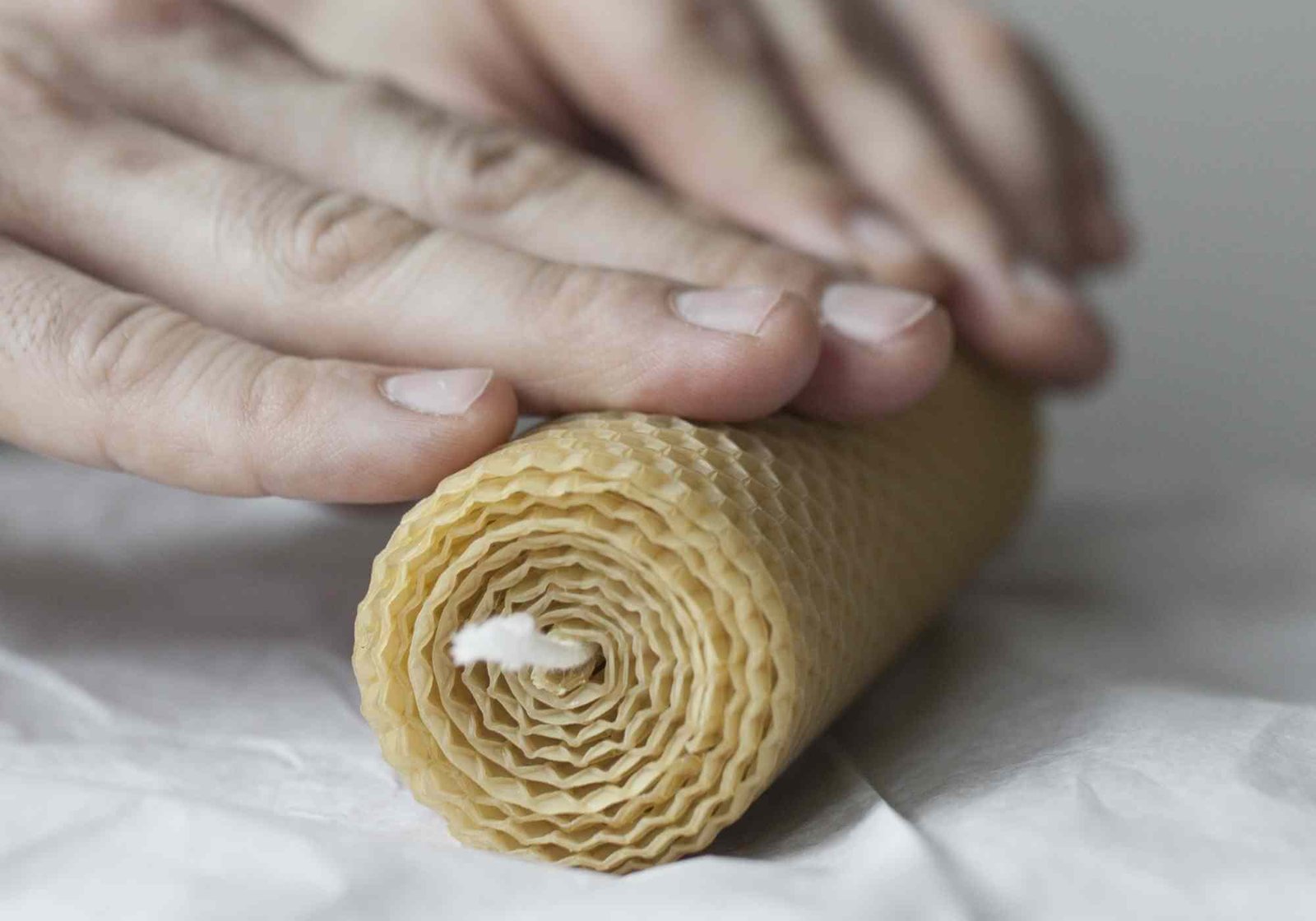Blog
In a small room I build a fire

Fire is sacred, fire is revered, fire is purifying... How often do we, longing for warmth and cosiness, especially in autumn or winter evenings, light our fireplaces or candles and reflect on the work we have done, rest, regain our strength, calm our minds and our hearts. There is a long tradition of making fires: we used to make altars, our grandparents and great-grandparents used to make stoves, but increasingly we burn only candles. Although few people know it, the paraffin candles that we are used to only came into being with the rise of industry. Before then, all homes had only real beeswax candleswhich they lit up during holidays or just when they ran out of light and warmth, which welcomed and welcomed everyone, and which not only lit up the house, but also made it smell like a summer cosy. Thanks to beekeepers, these little miracles of nature are slowly returning to our homes and hearts.
Wax - beekeepers' privilege
 Wax is an all-natural organic substance produced by bees. Yes, you read that right, bees don't collect wax from the fields, they produce this highly flammable substance themselves. And certainly not to keep warm. Wax is the building material that wild bees use to make honeycombs in the hollows of trees and on mountain slopes. Wax is mainly produced by young bees, just 12 to 16 days old. They mould the liquid secreted from a special gland in a way that even the best builders could not - into perfect hexagonal honeycomb meshes. All this without any "spirit level" or angles. They don't even need special mixers, putty knives or other tools - they do all the building work with their barely visible hands. And although they can't play Chopin, they certainly don't complain about their dexterity. The hexagon is a perfect example of the economy of making a bigger building with less material. Since such structures exist only in trees or beehives, beekeepers have been making candles since time immemorial, as there were not many brave souls who wanted to obtain wax from wild bees. Natural beeswax candle production is still a craft, hobby and pastime for beekeepers today. A pastime? If you doubt it, we invite you to try this calming but concentrated activity for yourself. "In the candle workshops that take place during the Brothers' Honey education sessions, this fun activity is already being discovered by the youngest and the much older ones, who are pleasantly surprised by this inspiring activity, which, at first sight, may seem much easier than it really is.
Wax is an all-natural organic substance produced by bees. Yes, you read that right, bees don't collect wax from the fields, they produce this highly flammable substance themselves. And certainly not to keep warm. Wax is the building material that wild bees use to make honeycombs in the hollows of trees and on mountain slopes. Wax is mainly produced by young bees, just 12 to 16 days old. They mould the liquid secreted from a special gland in a way that even the best builders could not - into perfect hexagonal honeycomb meshes. All this without any "spirit level" or angles. They don't even need special mixers, putty knives or other tools - they do all the building work with their barely visible hands. And although they can't play Chopin, they certainly don't complain about their dexterity. The hexagon is a perfect example of the economy of making a bigger building with less material. Since such structures exist only in trees or beehives, beekeepers have been making candles since time immemorial, as there were not many brave souls who wanted to obtain wax from wild bees. Natural beeswax candle production is still a craft, hobby and pastime for beekeepers today. A pastime? If you doubt it, we invite you to try this calming but concentrated activity for yourself. "In the candle workshops that take place during the Brothers' Honey education sessions, this fun activity is already being discovered by the youngest and the much older ones, who are pleasantly surprised by this inspiring activity, which, at first sight, may seem much easier than it really is.
Different heat
Wax candles little has changed in the production tradition. Although more modern tools, special wax cleaning machines and candle "makers" have been introduced, most of the work is still done by hand. All the good wishes and good thoughts put into the candles are not the only reason why wax candle heats differently from paraffin or soy wax. Beeswax burns brighter and warmer, and its unique smell... Honey, bee bread rollsthe smell of bees... The colour of the wax depends on what has been stored in it. It is the honey that turns naturally whitish wax yellowish. The more impurities in the wax, the darker it is and the richer the smell. In contrast, paraffin candles are unscented or have synthetic fragrances added. In addition, because they are made from petroleum products, beekeepers often compare them to a car that has started in the living room - soot, bad smells and harmful substances are guaranteed. Beeswax candles Not only are they not harmful, but they even emit substances that clean and purify the ambient air, helping to combat harmful micro-organisms in the environment. Maybe that's why bees never get a runny nose? ?
If you've ever watched a wax candle burn, you've probably remembered the calmness it gives off. Not only is it made with tenderness (try twisting just one candle and you'll know what I mean), but it burns with it. The wax gradually melts and burns, the wick doesn't crackle, the flame flickers evenly, rivulets of wax run down onto the tablecloth, and so it burns quietly, patiently, until it burns. That is true warmth and peace. Once you try it, they say, you can't stop. Once you've tried wax candles, you're enchanted, and you begin to enjoy their little miracles all the time. After all, you can never have too much heat.
Twist the candle, twist it to one side
Natural wax candlesThey are usually produced in two ways: by twisting and moulding. While twisted candles are marked with a natural honeycomb pattern, cast candles can be shaped in any form. Which are harder to make? Both require care and love.
The candles are made with silicone moulds, which you can make yourself. All you need is a container for pouring the silicone, silicone mix, the object you want to shape into a candle, a cotton (linen or other natural) wick and melted wax. First of all, you need to make a mould. To do this, pour the silicone you have made into a container (mix the two silicone components well and quickly) and dip the desired mould into it. It is important to follow the manufacturer's instructions and the specified setting time when making the silicone. So, once our future mould has set, we simply cut it lengthwise on one side so that it is easy to open and remove the used moulding item. Once the mould is made, we place the wick in the middle of the mould, stretch it well, making sure to secure it at both ends of the silicone mould. Then we can pour the melted wax inside. Secure the mould firmly with ties, straps or rubber bands to prevent the wax from spilling out accidentally. When the mould has cooled, carefully remove the candle, trim the bottom so that it stands flat, cut off the excess wick and dip the remaining tip in wax to make it easier to light. Are you tempted to try?
 To spin a candle for yourself, at first glance, seems like asking. All you need are beeswax plates, a wick and dexterous warm hands. Wax is a very pleasant material, but it is also a fast-decomposing material, so you need to be able to twist it with warm hands to make a nice candle that burns well. The beekeeping brothers advise you to warm your hands by rubbing the palms of your hands before you start to twist your first candle. So, once we have relaxed and warmed our hands, we can start to spin the candle. First, we coat the wick well with wax, crimp it, and then slowly spin the wax plate. The twisting should be as tight as possible to minimise the gaps between the wax plates. It is important to both 'smooth' and 'steady' the candle. Make sure that the wax plate is aligned on both edges and that it does not split. Also, twist very gently and calmly to avoid damaging the wax and distorting its texture. The tighter you twist the candle, the more beautifully it smoulders. So, patience!
To spin a candle for yourself, at first glance, seems like asking. All you need are beeswax plates, a wick and dexterous warm hands. Wax is a very pleasant material, but it is also a fast-decomposing material, so you need to be able to twist it with warm hands to make a nice candle that burns well. The beekeeping brothers advise you to warm your hands by rubbing the palms of your hands before you start to twist your first candle. So, once we have relaxed and warmed our hands, we can start to spin the candle. First, we coat the wick well with wax, crimp it, and then slowly spin the wax plate. The twisting should be as tight as possible to minimise the gaps between the wax plates. It is important to both 'smooth' and 'steady' the candle. Make sure that the wax plate is aligned on both edges and that it does not split. Also, twist very gently and calmly to avoid damaging the wax and distorting its texture. The tighter you twist the candle, the more beautifully it smoulders. So, patience!
And accepts and accompanies
Make yourself a candle to light your way... And candles are always lit: when we are happy, when we are sad, when we celebrate, when we cry. Well, at least they used to. Beeswax candles The flame, like nothing else, has the power to calm: it is said that when lit, you can even hear the bees buzzing, smell the fresh honey and breathe in summer. The scent and heat therapy of the home is given to us by the bees, who have been our helpers for untold years and thanks to whom our crops and all living nature ripen their fruits every year. It is perhaps a little symbolic that the wax candles of the bees, the bearers of life, both welcome us and, in the end, escort us, as if closing one cycle of nature and naturally moving on to the next. After all, in the old days, only candles made of real wax were blessed. Sad for the bee now that her wax is less warm, and sad for the man who warms up but never gets warm with a cold flame.If you have never tried to light a real wax candle, give it a try. Maybe even in a small room it will be more cosy than in a palace, and those ashes or toads will shine like princes and princesses in the light of real candles. Perhaps the palace will no longer seem cold and large, and the people too inaccessible, if everyone sticks to the light and warmth that brought us here, that has accompanied us on all life's journeys, even up to the mountains of the Ural Mountains, and that has seen us off to a brighter tomorrow.




